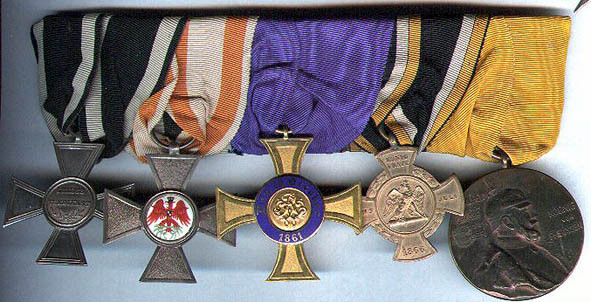|
Awards for military merit have a long
history in Prussia. In 1793 medals for „Merit for the
state“ began being awarded. These medals for military as
well as for civil merit went through some changes since
they were established. Only the type of ribbon showed
the difference between the military and civil character
of the medal.
Due to the fact, that there is
still a lot of mistakes in the common literature I will
only write about the military type in its first class;
awarded on a black ribbon with two white strips.
The biggest change during this medals
history was the upgrade from an actual medal to a cross.
This change was performed on September 30, 1814. One
reason was a cost reduction from 13 Talern to less than
1 Taler.
While the second class, of the
from now on named (Militär-Ehrenzeichen) Military Honor
Medal, remained the same in shape, the first class was
coined on October 08, 1814, by the Berlin Jeweler
Gebrüder Wagner. The design of this Cross. (Type 1) was
done by King Friedrich Wilhelm on September 30,
1814. The avers shows the crowned kings initial
"FW.", the reverse: "Verdienst um den
Staat (Merit for the state)". Before January 1815 the new medal wasn’t available
for awarding. The gross of this new award was given to
soldiers of the allied armies because the iron cross was
newly issued on March 10, 1813. In 1828 all crosses of
the first type were awarded for military and civil
reasons (keep in mind that only the ribbon made the
difference between a civil (Allgemeines Ehrenzeichen) and a military
award (Militär-Ehrenzeichen)). The
Generalordenskommission ("the general orders issuing
ministry") ordered on October 25, 1828, 200 new crosses
from the Berlin orders jeweler Hossauer for the old
price. Since they weren’t ordered in 12lötigem
(750/1000), instead of in 15lötigem (937,5/1000) silver,
Hossauer declined their making because he thought they
would be to soft for this kind medal. Therefore the
Berlin jeweler Friedrich Wilhelm Hanff started coining
this medal in 15lötigem silver in the end of November
1828 (Type 2).
Since the Military Honor Medal 1st Class was only
awarded between 1814 and 1917 the 2nd type could have
only functioned as a substitute piece lost by their
bearers. Therefore the biggest number of these crosses
were awarded as Civil Honor Medal 1st Class on its white
ribbon with orange stripes, approx. 2000 pieces.
Military Honor Medal 1st class, type
1 with suspension loop type 2
On January 01, 1830, the 1st class
of the Civil Honor Medal was transformed into the
Red-Eagle-Order 4th class. With the upcoming war 1848/49
the Military Honor Medal 1st class was awarded in a new
from (Type 3). These new pieces looked, except for the
porcelain medallion, identically like the second type of
the Red-Eagle-Order 4th class from 1846, in shape and
dimensions. Instead of the porcelain medallion the cross
bearded the three line inscription: “Verdienst um den
Staat“ (“Merit for the State”).
This new form only existed from
1848 to 1864, regarding the fact that it was only
awarded in 1848/49 in a very scarce number.
Military Honor Medal 1st class, type 4 without makers
mark hollow made from 1864
Ordered by the King on February
27, 1864, the parallel design development to the Civil
Honor Medal was ended. From now on the Military Honor
Medal shows the two line inscription: „Kriegsverdienst“
(“Military Merit”) (Type 4). This type comes with the
makers mark “AW”, punched in the medallion cylinder,
without any marks and with the scratch mark “W”.

Military Honor Medal 1st class, type 4
with makers mark "AW" for 1866
Award statistics:
|
Timeframes
|
Type
|
Number awarded
|
|
1814-17
|
1 |
11 |
|
1848-49
|
3 |
12 |
|
1860
|
3 |
2 |
|
1863
|
3 |
1 |
|
1864
|
4 |
191
|
|
1866
|
4 |
415
|
|
1867
|
4 |
29 |
|
1902
|
4 |
52 to Russians
in China |
|
1895-1906
|
4 |
201 for the
colonial wars |
The following medal bar was worn by a
Schutztruppler for his time in
South-West-Africa:

Bernhard von Schenk received his
medal for the 1866 wars:

© A.
Schulze Ising, XII/99
|